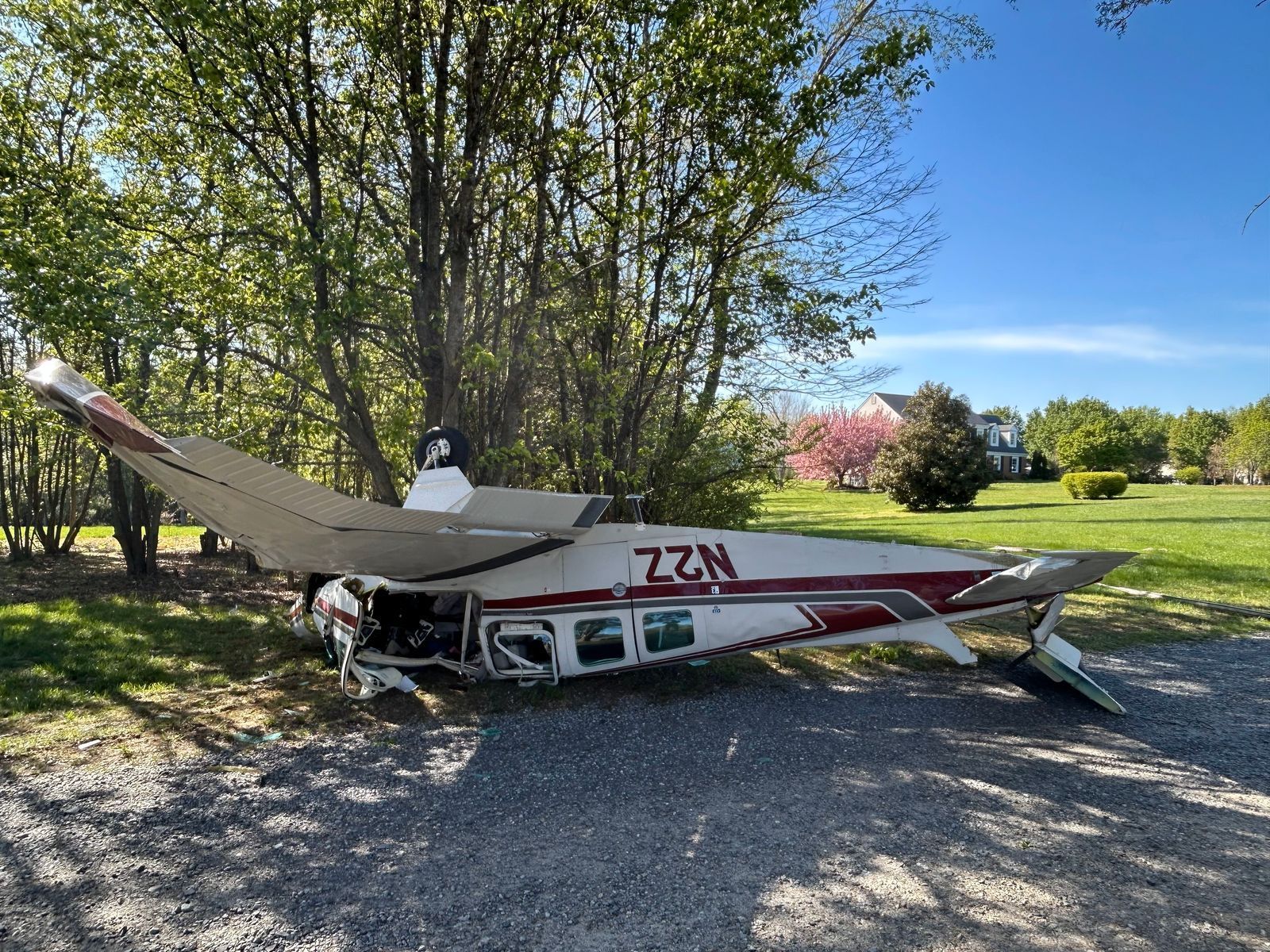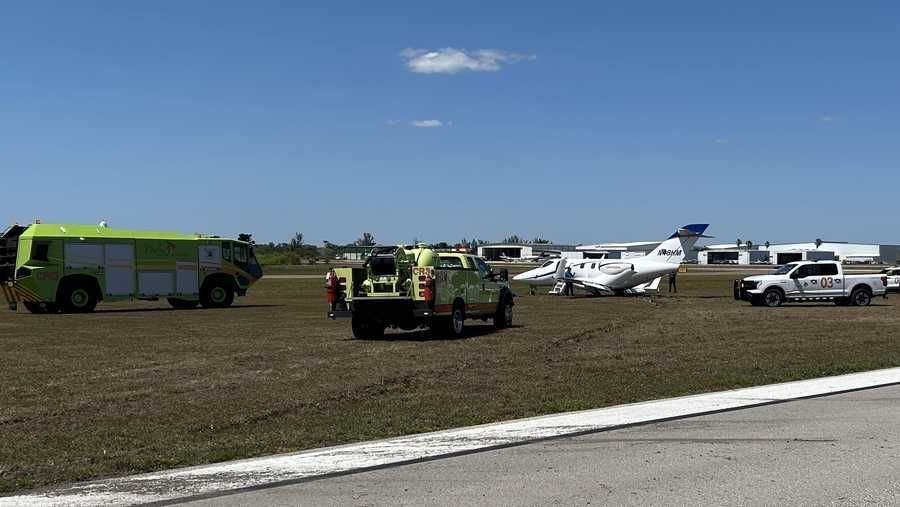ARFF Daily News
Published on:
Thursday the 10th of April, 2025
Oil issues force small plane to make emergency landing in Fredericksburg, 2 people injured
by Winston Rogers
FREDERICKSBURG, Va. (7News) — Two people received minor injuries after their plane landed upside down and into trees in Fredericksburg, Virginia, according to a Spotsylvania County Fire official.
Emergency crews were called to the 11000 block of Scarlet Oak Road shortly after 3 p.m. after reports that a single-engine plane landed in trees. The area sits about 8 miles from downtown Fredericksburg and 60 miles from D.C.
The plane, a Beechcraft, had taken off from Leesburg Executive Airport en route to an airport in the Hampton Roads area when an oil pressure issue prompted an emergency landing.
At the scene, officials said a plane was found upside down with two people inside. No nearby houses were damaged, and both occupants were taken to the hospital with non-life-threatening injuries.
Officials did not provide details on the type of plane involved in the incident.
As of 4:30 p.m., crews remained on scene to investigate the incident and clear a small fuel leak, officials said.
https://wjla.com/news/local/small-plane-crash-landing-fredericksburg-virginia-upside-down-upside-down-fuel-leak-hospital-injuries-spotsylvania-county-fire-rescue-emergency-police-sheriff-crews


Jet veers off runway after landing at Naples Airport
By Tyler Watkins
NAPLES, Fla. —
A jet veered off the runway while landing at the Naples Airport Wednesday afternoon.
According to the Naples Airport, a Honda Jet ended up in the grass. The pilot was the only one onboard at the time of the incident.
Officials said no one was injured, but they do not know what caused the jet to go off the runway at this time.
The jet will be removed once the airport receives permission to move it from the Federal Aviation Administration. Officials said the airport is operating as normal but one runway is closed.
https://www.gulfcoastnewsnow.com/article/jet-veers-runway-landing-naples-airport/64435006

PAL confirms plane emergency landing in Haneda Airport, cites airconditioning unit smoke
by Mary Antalan
The Philippine Airlines (PAL) confirmed on Thursday that Flight PR102 bound for Los Angeles, USA, made an emergency landing at Haneda Airport in Japan due to smoke coming from an airconditioning unit.
"Philippine Airlines confirms that Flight PR102 – which departed from Manila on April 9, Wednesday en route to Los Angeles, diverted to Haneda Airport due to initial findings of smoke emitting from 1 of 2 air conditioning units," PAL said in a statement.
The Boeing 777 aircraft, with registry number RPC 7782, was carrying 355 passengers and landed safely.
Passengers remained onboard as PAL coordinated closely with airport authorities in Haneda to ensure a smooth and safe disembarkation.
"Rest assured that we are in full coordination with Philippine government authorities through the office of the DOTr Secretary and local airport authorities in Haneda. We will provide updates as soon as more information becomes available," PAL added.
Earlier, Department of Transportation (DOTr) Secretary Vince Dizon confirmed to DZRH News that the flight experienced a "mid-air" issue that prompted the crew to turn the aircraft around and land in Haneda as a safety precaution.
"‘Yung PAL PR 102 na Manila to Los Angeles, nakakuha tayo ng report very early this morning, 5:00 ng umaga. Nagkaroon po ng aberya in flight, medyo usok na lumabas sa cabin at kailangan nito bumalik at nag-landing po ito sa Haneda sa Japan," Dizon said during DZRH's Dos Por Dos interview.
Dizon said many passengers were stressed and uncomfortable, with some reportedly stuck inside the aircraft for more than three to four hours following the emergency landing.
Authorities immediately coordinated with PAL, and aircraft doors were eventually opened to ventilate the cabin and ensure the welfare of the passengers.
The DOTr also sought assistance from Japanese Ambassador Endo Kazuya to help PAL provide proper accommodations for the passengers, especially those who may not hold Japanese visas and are unable to exit the transit area.
https://dzrh.com.ph/post/pal-confirms-plane-emergency-landing-in-haneda-airport-says-due-to-aircondition-unit-smoke

NTSB Final Report: Diamond Aircraft Ind Inc DA40
Pilot Moved The Throttle Control Lever Forward And Heard A “Pop” Sound Come From The Engine
Aviation Investigation Final Report
Location: Kapolei, Hawaii Accident Number: ANC24LA005
Date & Time: December 4, 2023, 12:50 Local Registration: N691YW
Aircraft: Diamond Aircraft Ind Inc DA40 Aircraft Damage: Substantial
Defining Event: Loss of engine power (partial) Injuries: 1 Serious, 1 Minor
Flight Conducted Under: Part 91: General aviation - Flight test
Analysis: While enroute the pilot moved the throttle control lever forward and heard a “pop” sound come from the engine, followed by a rumbling noise and an airplane vibration. The pilot pulled the throttle back to its original position in an attempt to stop the rumbling and vibrations and turned the airplane back toward the runway for an emergency landing.
Engine power was not restored, and the airplane began to lose altitude, so the pilot performed a forced landing, which resulted in substantial damage to the fuselage and both wings. Postaccident examination revealed that baffling from the exhaust muffler had broken loose, blocking about 3/4 of the opening. The blocked exhaust reduced the volumetric efficiency of the engine cylinders, resulting in the partial loss of engine power.
Probable Cause and Findings: The National Transportation Safety Board determines the probable cause(s) of this accident to be -- A partial loss of engine power due to lose baffling from the muffler, which resulted in an obstruction of the exhaust system.
FMI: www.ntsb.gov

Today in History
52 Years ago today: On 10 April 1973 Invicta International Airways flight 435, a Vickers Vanguard, impacted a mountain while on approach to Basel/Mulhouse Airport, killing 108 occupants; 37 survived the accident.
Date: Tuesday 10 April 1973
Time: 10:13
Type: Vickers 952 Vanguard
Owner/operator: Invicta International Airways
Registration: G-AXOP
MSN: 745
Year of manufacture: 1962
Total airframe hrs: 16367 hours
Engine model: Rolls-Royce Tyne 512
Fatalities: Fatalities: 108 / Occupants: 145
Other fatalities: 0
Aircraft damage: Destroyed, written off
Category: Accident
Location: 15 km S of Basel/Mulhouse Airport (BSL) - Switzerland
Phase: Approach
Nature: Passenger - Non-Scheduled/charter/Air Taxi
Departure airport: Bristol Airport (BRS/EGGD)
Destination airport: Basel/Mulhouse Airport (BSL/LFSB)
Investigating agency: AIB
Confidence Rating: Accident investigation report completed and information captured
Narrative:
Invicta International Airways flight 435, a Vickers Vanguard, impacted a mountain while on approach to Basel/Mulhouse Airport, killing 108 occupants; 37 survived the accident.
The Vickers Vanguard was operating on a charter flight from Bristol (BRS) to Basle Mulhouse (BSL). After entering the Basle Mulhouse terminal area, the flight was cleared to continue to the BN NDB. Weather was poor at that time: cloud base at 120 m (390 feet) and a reported runway visual range of 700 (2300 feet) and 1300 m (4250 feet). On arrival at the BN beacon the crew were cleared to descend to 2500 feet and were asked to report over the MN beacon before making a 90 degree left hand turn to finals for runway 16. At 09:56 the crew reported at 2500 feet, followed by a position report of the MN beacon at 09:57:40. When on finals over the BN beacon, the crew reported turning outbound and said they would report at the MN beacon again for another approach. When the crew reported overhead the BN beacon again, the plane was in fact overhead the airfield, flying parallel to the ILS localizer beam. After 1,5 minute the aircraft began to overshoot, correctly making an initial turn to the west. The crew, now flying well south of the field, were instructed to report back over the MN beacon. When reporting over the MN beacon again, before it would have to turn left for finals, the plane was in fact overhead the BS beacon, a beacon located to the south of runway 16. At 10:11:25 the crew reported over the BN beacon on finals and was cleared to land. In fact the plane was now flying 3 miles South of the field and 1 mile west of the extended centerline. Two miles further on Basle ATC asked the crew "Are you sure you are over the BN?". The captain replied "I think I've got a spurious indication. We are on the LO... on the ILS now, sir". Half a minute later the captain radioed "BN is established on localizer and glide path; the ADF's all over the place in this weather." Last radio contact was when the captain reported at 1400 feet, to which ATC replied that the flight was probably to the south of the airport. At 10:13 the plane brushed against a wooded range of hills and crashed 15 km from the airport. The aircraft disintegrated, except for the tail section, were most of the survivors were found.
PROBABLE CAUSE: "A loss of orientation during two ILS approaches carried out under instrument flight conditions. The following factors contributed to the occurrence of the accident:
1) inadequate navigation, above all imprecise initiation of final approach as regards height and approach center-line.; 2) confusion of aids; and 3) insufficient checking and comparison of navigational aids and instrument readings (cross and double checks).
The poor reception of ht medium wave beacons and technical defects in LOC receiver No.1 and glide slope receiver no.2 made the crews navigational work more difficult."

